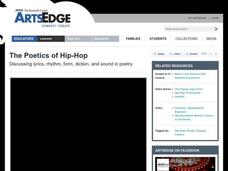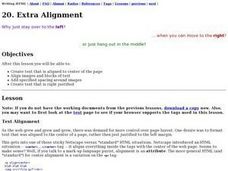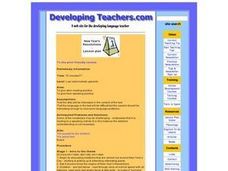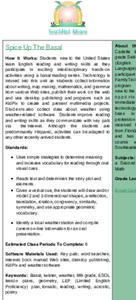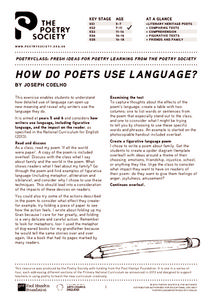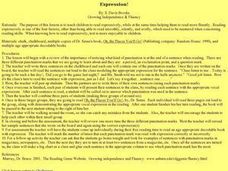Baylor College
Modeling an HIV Particle
Models are an important part of science; they help us see the world on a scale that works for us. In the first of five lessons on HIV, learners make a paper model of the HIV virus that is about 500,000 times larger than the actual virus....
Baylor College
Your Nutrition Needs
It takes some work to ensure you have a balanced diet, but once you know the types of foods that are good for you, it becomes second nature. In the sixth of seven lessons about energy and nutrition, learners create a healthy eating plan...
Baylor College
Energy Sources
Take the concept of burning calories to a more literal level in the second of seven lessons about energy in the realm of food and fitness. Using simple materials, groups will burn breakfast cereal and a pecan to see which one gives off...
Curated OER
Color Coding Richard III
Tenth graders use color-coded annotation or text-marking to analyze a passage from Richard III. In this text analysis lesson, 10th graders read a passage from Richard III and use colored pens to analyze the text. Students then devise a...
Curated OER
On Your Mark, Get Set, GO!
Students in order to become a fluent reader need to read often and repeat what they read over and over. Repeated reading helps students gain better knowledge of text. Fluent readers recognize words automatically and with this automatic...
Curated OER
Paw-er up for PowerPoint
Sixth graders explore how to present research information on a PowerPoint Presentation.
Curated OER
Getting the Point!
Students explore the American cattle industry history. In this United States history and reading comprehension cross curriculum lesson, students read an article about the history of longhorn cattle, then answer comprehension questions on...
Curated OER
A Hidden Beauty
Expose the beautiful mystery of bulbs as young botanists learn all about these fascinating plants. They glean information from a short text before observing actual bulbs (consider an onion), and comparing their findings with predictions....
Curated OER
The Poetics of Hip Hop
Students consider the role of rhythm, form, diction, and sound in poetry. In this integrated arts lesson, students discuss the attributes of poetry as they analyze Shakespearean sonnets, hip hop music lyrics, and poems by Nikki...
It's About Time
A Running Start and Frames of Reference
Ttake learning to the next level! Individuals research inertial mass, a physical property of matter, and apply what they learn through a series of activities designed to stimulate the senses. They demonstrate Galileo's Principle of...
Curated OER
Ancient Egypt
Pupils complete a series of activities to discover life in ancient Egypt. They create want ads for pyramid workers, design vocabulary flash cards and dictionaries, and research famous Egyptians. They also research the "Curse of the...
It's About Time
Concentrating on Collisions
How important is momentum? Pupils investigate and apply the definition of momentum as they conduct analyses during a series of one-dimensional collisions. They infer the relative masses of two objects by carefully staging and predicting...
Building Background Knowledge: Learning About the Historical and Geographical Setting of Esperanza Rising
Set up your class to read Esperanza Rising, by Pam Munoz Ryan, through a class read-aloud and exploration of the setting. The detailed lesson plan outlines each step. First, class members read over the first few pages and focus on the...
It's About Time
Curved Mirrors
Discover concave and convex mirrors using a laser light. Scholars experiment with real and virtual images before reading a handout and completing homework questions. Included extensions greatly benefit learners, so take...
Curated OER
Language Arts: Racing for Fluency
Students improve fluency through drills to increase quickness and smoothness. In pairs, they practice reading sentences out loud, each time increasing their fluency. Finally, students play a game of timed readings using a stop watch to...
Baylor College
Servings and Choices
An important part of balancing caloric intake to energy expenditure is knowing how many Calories you are consuming. In the fifth of a seven-lesson plan series on food and energy, learners estimate their daily caloric intake, then use a...
Curated OER
Graphing
Intended for a faith-based classroom, this activity requires second graders to create a survey, conduct the survey in multiple classrooms, and graph the results. They can choose between creating a picture or bar graph, or you can require...
Curated OER
Introducing the Memo
Students explore memos to gather important information. In this memos lesson, students interpret memos and answer questions based on the information. Students define the parts of a memo. ...
Curated OER
Extra Alignment
Students create text that is aligned to the center of the page. They align images and blocks of text. They add specific spacing around images. They create text that is right justified.
Curated OER
New Year's Resolutions -Lesson plan
Students study the origins of New Year's Resolutions while practicing taking dictation and identifying interesting points in a piece that is read to them. They investigate the types of things that people resolve on the first day of the...
Curated OER
Spice Up the Basal
Fifth graders study English reading and writing skills as they participate in exciting interdisciplinary hands-on activities using a basal reading series.
Poetry Society
How do Poets Use Language?
Why do writers choose the language they do? Here's a resource that has the poet himself answer that very question. Joseph Coelho explains why he chose the words and images he used in his poem, "If All the World Were Paper."
Curated OER
Expression!
Students organize ways of reading expressively as well as fluently. They encounter books by Dr. Seuss within this lesson. Practice, practice and more practice makes perfect. Punctuation marks are reviewed for accuracy.
Curated OER
Making a Travel Brochure
Third graders research the cities in Florida and discuss information about that city. In this travel brochure lesson, 3rd graders develop a list of attractions, slogan, and find facts about the city they are studying. ...










